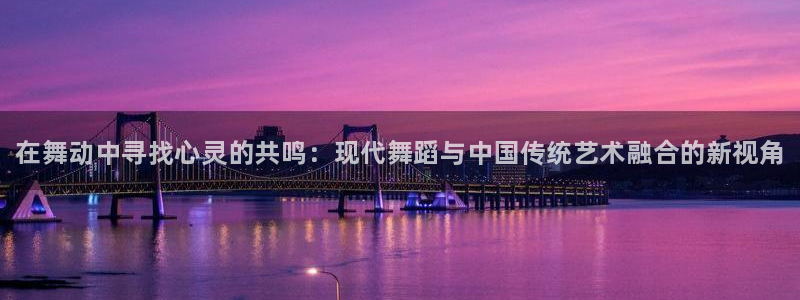欢迎访问山东MK体育官方正版下载产业有限公司!
 中文(简体)
中文(简体) 欢迎访问山东MK体育官方正版下载产业有限公司!
 中文(简体)
中文(简体) 作者:mk体育app官网在线 发布时间:2025-08-08 次浏览

从“中国传统艺术”到“现代舞蹈”,是中国当代艺术的核心部分之一。mk体育官网入口MK体育官网下载招商电话说:自1973年中国新艺术运动兴起后,文化大革命对文艺创作的全面影响,中国艺术界开始寻求新的发展方向与路径。
在众多艺术家中,以黄永玉、林风眠和刘海粟为代表的中国现代画坛代表人物,更强调传统与现代艺术之间的对话。他们对于西方抽象艺术的吸收与借鉴,以及对中国传统文化的运用,让其作品呈现出一种独特的东方气韵,使后世的中国艺术得以在国际上获得更大的认可。
,在探讨中国当代艺术的发展时,我们应注意到,传统艺术和现代舞蹈虽同属于当下中国艺术创作领域,但各自的艺术语言、审美观念及历史背景却有显著差异。而现代舞与中国传统艺术的融合,更可以被视为对两个艺术体系的一次突破与创新。
在《舞动中寻找心灵的共鸣》一文中,作者尝试以一种全新的视角审视现代舞蹈与中国传统艺术的融合现状,从宏观的角度阐述了两者之间如何能够相互渗透、相互影响。MK体育官网下载招商电话说:文章其次介绍了中国传统的艺术形式——京剧,通过分析其独特的文化背景和审美特征,揭示了中国传统文化在当代艺术创作中的重要性;接着探讨了西方现代舞的艺术流派——芭蕾舞,对传统舞蹈的吸收与创新,以及两者在国际舞台上的表现力;之后将从“中国传统艺术”到“现代舞蹈”,出一个共同的核心理念:通过交融、对话和创新,让传统艺术与现代舞蹈能够更加深入地交流与融合。
文章强调,中国当代艺术的发展应当以尊重传统文化、继承与发展为核心,而这种发展的方向也应当是多元化的。中国应继续吸收西方现代舞的艺术精髓,同时保留并发扬中国传统艺术的特色。这种平衡既符合当下中国艺术创作的发展趋势,也是实现文化自信与世界交流的重要途径。
在探讨《在中国传统艺术和现代舞蹈之间寻求共鸣》一文中,作者则通过具体例子,阐释了如何将传统艺术与现代舞蹈相融合的艺术实践方法。例如,可以借鉴中国传统音乐、中国画等艺术形式中的元素,创作出既具有东方韵味又富有创新性的舞剧;或者将中国传统服饰与现代芭蕾舞结合,为观众呈现一种全新的视觉体验。
文章强调,艺术创作应注重多维度的探索和实验,以期获得更加丰富和多元的艺术价值。mk体育app官网在线MK体育官网下载招商电话说:同时,作者也鼓励在融合过程中,尊重传统、兼容并蓄,避免文化隔阂带来的艺术局限性。
,《在中国传统艺术和现代舞蹈之间寻求共鸣》一文旨在探讨中国当代艺术的发展趋势,并提出一系列策略与方法,以期让传统艺术与现代舞能够在国际舞台上更加紧密地联系在一起。MK体育官网下载招商电话说:这不仅是对艺术创作的创新追求,更是对中国当代艺术历史的一次梳理,同时也为其他艺术家提供了灵感借鉴。
,在全球化的今天,中国艺术界应积极拥抱和探索各种文化形式的交融与碰撞,以开放包容的心态迎接挑战,让世界看到更真实的中国文化面貌。同时,作为读者,也应当更加珍视并主动参与到这些艺术交流中来,共同促进文化创新与艺术繁荣的美好愿景。
通过《在中国传统艺术和现代舞蹈之间寻求共鸣》一文,我们不仅能够 gain a deeper understanding of Chinese contemporary art, but also gain insights into the intersection of traditional and modern art. Through a new lens, we can reflect on how traditional art styles such as Chinese opera and traditional Chinese paintings are complemented by the world of Western modern dance, and explore ways in which these two worlds can be more closely intertwined.
In this article, we'll discuss how to integrate traditional Chinese arts with the world of modern dance. Through a new perspective that views both traditions through the eyes of contemporary art, we will gain insights into the merging process. The authors argue that understanding traditional Chinese arts is not just about preserving and appreciating them; they also need to embrace cultural diversity in order to avoid limiting their artistic vision.
The article discusses the use of various artistic forms within China's traditional culture—such as opera and Chinese painting—and highlights how these traditions can be combined with modern dance. For instance, we can draw inspiration from elements found in traditional art forms like Chinese calligraphy, painting, and poetry. Or, we can combine Chinese paintings with modern dance to create a new type of visual experience that reflects the changing beauty of life.
The article emphasizes the importance of maintaining cultural diversity so that all creative activities are inclusive and open. In this way, artists can appreciate different perspectives and ways of expressing themselves.
By sharing these ideas about finding harmony between traditional Chinese arts and modern dance in contemporary art, we not only gain deeper insights into Chinese contemporary art but also learn valuable lessons for the future generations, who will be better equipped to understand and appreciate diverse cultural expressions around the world.
版权所有 鲁ICP备13004315号-3
Copyright 2020-2021山东MK体育官方正版下载产业有限公司 ALL Rights Reserved